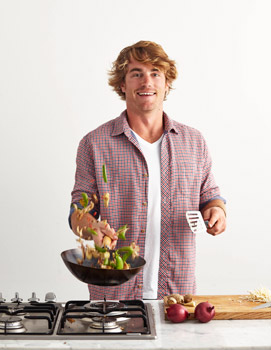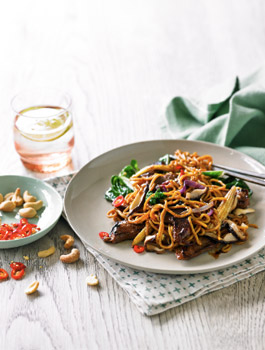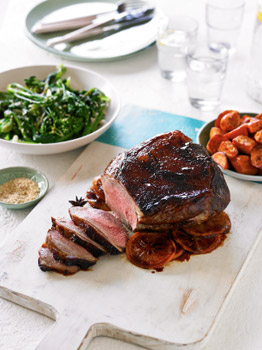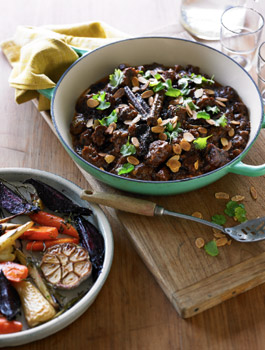Hayden Quinn The Dinner Project Interview and Recipes

Hayden Quinn The Dinner Project Interview and Recipes
Aussies' face a variety of speed humps in their kitchens every day, but Hayden Quinn shows us that it's possible to put a healthy meal on the table, no matter what the circumstance. Hayden makes life easier and a whole lot tastier, when The Dinner Project premieres Sunday, November 2 at 7.00pm on LifeStyle FOOD, only on Foxtel.
Cooking is more than throwing a few ingredients in a pan. Time, budget, skills, ideas, knowledge and nutrition play a huge factor in our everyday lives and meals. In the six-part half-hour series, Hayden – the newest member for the LifeStyle FOOD family – tackles every angle. He'll move in with six families around the country to develop an understanding on what their lives entail. With meal plans and recipes for breakfast, lunch and dinner, Hayden will equip them with the tools they need to create quick, easy and nutritious meals, no matter their circumstances.
There are six common issues that hinder Australian's in the kitchen. Hayden researches the lifestyles and nuances of everyday Australians to inspire and create delicious meals in the kitchen. There's the -skill's poor' with Lani, a young Melbourne foodie who eats out more than in; the -budget conscious' with Digby and Daniel, a couple of struggling students from Geelong; the -time poor' with Kath and Seb, a busy family of 5 from Hammondville; the -knowledge poor' with Chris, a Mine Rescuer and his family from Newcastle; the -nutrition poor' with Lyn and Pete, the Gold Coast empty-nesters and the -ideas poor' with Sally and Peter, cattle and sheep farmers from Armidale.
 Stir-Fried Beef, Asian Greens, Cashews
Stir-Fried Beef, Asian Greens, Cashews
Serves: 4
Preparation: 20 Mins + Marinating
Cooking: 15 Mins
Ingredients
450g packet fresh hokkien thin noodles
80ml (1/3 cup) peanut oil
1 red onion, cut into wedges
2 cloves garlic, thinly sliced
2cm piece ginger, peeled, grated finely
200g small shiitake mushrooms, trimmed
60ml (¼ cup) Chinese rice wine (Shaoxing)
2bn baby buk choy, trimmed, quartered lengthwise
2bn baby pak choy, trimmed, quartered lengthwise
1pn baby corn, halved lengthwise
50g (1/3 cup) roasted cashews
Beef Marinade
60ml (¼ cup) tbs soy sauce
60ml (¼ cup) sweet soy (kecap manis) sauce
60ml (¼ cup) satay paste
1½ tsp sesame oil
2 tsp corn flour
650g beef rump steak, thinly sliced
Method
Prepare fresh hokkien noodles according to manufacturers instructions.
To marinate beef, whisk soy sauces, satay paste, sesame oil and flour together in a large bowl. Add beef and toss well to coat. Marinate for 25 minutes before cooking. Drain beef well and keep drained marinade. Heat 2 tablespoons peanut oil in a large wok over high heat. Add beef and stir-fry for 3 minutes until browned and just cooked. Set aside.
Heat remaining 2 tbs oil in large wok over high heat, add onion, garlic, ginger and mushrooms. Cook for 5 minutes or until onions and mushrooms have softened. Add reserved marinade and Chinese rice wine with Asian greens and baby corn. Stir-fry for 2 minutes or until Asian greens have wilted and corn is just cooked. Add beef and any beef juices with noodles and stir-fry for a further 2 minutes until noodles have warmed through.
Divide Stir-fry among plates and scatter with roasted cashews. Serve with sliced chilli.
Recipe Notes & Tips:
Chinese rice wine (shaoxing) is available from the Asian isle in supermarkets. Substitute with beef stock our water.
Rump steak is a great all rounder and is perfect for a variety of cooking methods. Other good cuts to use for stir fry are beef blade, sirloin or scotch fillet or lamb leg steaks and backstrap/eye of loin.
Meat Standards Australia (MSA) – MSA is a quality grading system designed to help you select tender, tasty and juicy beef and lamb every time. For cuts to be graded MSA, certain standards must be maintained from paddock to plate. MSA grades each cut for a number of suitable cooking methods to ensure the best eating experience. To find MSA beef or lamb look for the symbol at your butcher or supermarket.
Make sure stir-fry strips are cut in even lengths and thickness, oil the meat before putting it in the pan and cook in batches to prevent it stewing.
Make your own sauces rather than buying pre-made options, that way you know what is in it and there are many flavour variations.
Hayden – a Northern Beaches surfer found his love for cooking at a young age watching his mum cook in the family kitchen. He shot to fame, after appearing as a popular contestant on MasterChef Season 3 in 2011, and since then he has continued to share his love for travel, fresh, healthy produce, cooking, the ocean and people through his blog and cookbooks. The Dinner Project is produced by Ensemble in conjunction with Meat & Livestock Australia, exclusively for Foxtel's LifeStyle FOOD channel.
The Dinner Project premieres on LifeStyle FOOD Sunday, November 2 at 7.00pm.
 Star Anise & Orange Roasted Beef Blade Roast, Sweet Potato, Choy Sum, Brocolini
Star Anise & Orange Roasted Beef Blade Roast, Sweet Potato, Choy Sum, Brocolini
Serves: 6
Preparation: 30 Mins + Resting
Cooking: 1¼ Hrs
Ingredients
5 whole star anise
2 oranges, zested, juiced, plus 1 extra thinly sliced orange
180ml (¾ cup) honey, warmed
1.5kg Blade roast, fat trimmed
2 tbs olive oil
5 small sweet potatoes, cut into rough wedges
2bn baby choy sum, trimmed
3bn brocolini, trimmed
60ml (¼ cup) oyster sauce
1 tbs toasted sesame seeds
2 stalks green onion, thinly sliced
Method
Preheat oven to 180C and line the base of a large shallow rectangular roasting pan with baking paper. Whisk together star anise, honey, orange juice and zest until combined. Line the base of the roasting pan with the extra sliced orange and place your beef blade roast on top and brush with orange mixture; season to taste. Roast, basting frequently, for 1 hour 15 minutes or until cooked to your liking. Rest, covered loosely with foil, for 20 minutes before carving, to serve. Place remaining basting mixture in a small saucepan over medium heat. Bring to the boil and simmer for 5 minutes or until reduced to a syrupy consistency. Set aside and keep warm until ready to use.
Meanwhile, place sweet potato in a separate large roasting pan with oil and toss well to combine; season to taste. Roast for 35 minutes or until golden and cooked.
Blanch baby choy sum and brocolini in boiling water until tender. Place in a large bowl with warmed oyster sauce and toss well to combine; season to taste.
Recipe Notes & Tips:
Using a small sharp knife, make shallow incisions in the beef and insert star anise and orange peel.
How to carve a roast – the principle of carving is to obtain the greatest number of large, slices of meat from the roast. Whatever the size or shape of roast, some basic guidelines always apply. Firstly it is important that you rest the meat before using a sharp knife to carve on a board. When cutting your roast use a slicing rather than a sawing action with a small amount of pressure to prevent damaging the beef. Finally carve against the grain to shorten the meat fibres, which will aid tenderness.
Take the beef roast out of the fridge 15 minutes before cooking to ensure it cooks evenly.
Rest the beef before carving to allow the juices redistribute through the roast. A good rule of thumb is 1 minute per 100g.
Other cuts of beef suitable for roasting include the rump roast, rump cap, sirloin roast, scotch fillet roast.
Interview with Hayden Quinn
Question: What inspired the concept of The Dinner Project?
Hayden Quinn: The Dinner Project came about from a passion of mine to get Aussies back in the kitchen and cooking real food for their family and friends, simple stuff that all of us can tackle at home no matter what might be holding us back; crazy work hours, no idea, busy with the kids, no money, that sort of thing. For me it was also about getting people back together and sharing not only a meal over the dinner table but also stories, smiles, laughs and fun times which we sometimes miss in today's hectic world.
Question: What types of recipes will you be cooking on The Dinner Project?
Hayden Quinn: The recipes in The Dinner Project are all very simple and accessible for the home cook, this show isn't about blowing people away with the craziest recipes, it's about me sharing some tried and tested favourites which I love cooking at home myself and even if you have a little skill you should be able to pull these bad boys off
Question: How is your cooking show different?
Hayden Quinn: I guess it's different that I get to spend the night with my hosts (laughs) (on the couch or the spare room that is!). Seriously though, from this it's all about a shared learning experience. I share my passion through food and they then share a bit of their lives with me, and some of those lives are very interesting (laughs).
Question: What did you learn when research Australian meal and eating lifestyles for the show?
Hayden Quinn: I guess the most shocking part for me was finding out the number of people who dont actually cook at home, the families who don't share meals at the dinner table anymore! It seems everyone is just too busy! For me when I was growing up meal time was always so important, whether it be a special night in or just a quick rushed nothing in the cupboard scrambled eggs.
Question: What advice do you have for Australians who struggle with dinner, every night?
Hayden Quinn: Make sure you have some good staple recipes up your sleeve, like the ones we will be doing in The Dinner Project, and then, try and use the best ingredients you can get a hold of within your budget, have fun with it, have some friends around (makes you a little accountable (laughs)) and enjoy the feeling of feeding people you love.
Question: Why have you chosen to focus mostly on beef and lamb recipes?
Hayden Quinn: The main focus was having nice healthy nutritious recipes and we chose to try and highlight how important beef and lamb is for everyday Aussies, high in protein, rich in iron and zinc, packed full of the good stuff. We should include 3-4 serves of red meat, like beef and lamb, in our diets every week, so we tried to use different cuts of both…some common and others that are cheaper and a little less known.
Question: Why is it important to you to educate Australians on how they can create simple, healthy recipes with minimal cost and fuss?
Hayden Quinn: It's important because otherwise people turn to junky take away or stuff that they just keep doing time and time again.
Question: What are your five most commonly used ingredients, in the kitchen?
Hayden Quinn: mmmmm....olive oil, chili, garlic, cumin, beef!
Question: What inspires you when creating new recipes?
Hayden Quinn: My peers, my travels, people I meet along the way haha and what my mates request I cook!
Question: If you had a dinner party, this weekend, what entrée, main and dessert would you serve?
Hayden Quinn: Ohhhhh tricky one (laugh) there is no synergy in this, it's a real mix and match, but I love all these three things, beef tartar to start, then slow roasted lamb shoulder with roasted root vege's (a great sharer) then to finish I have to have brownies with vanilla ice cream (laughs).
 Beef Casserole, Cinnamon, Dried Plums
Beef Casserole, Cinnamon, Dried Plums
Serves: 6
Preparation: 35 Min
Cooking: 2 Hrs
Ingredients
2kg boneless chuck steak, cut into 2.5cm pieces
35g (¼ cup) plain flour
60ml (¼ cup) olive oil, + 2 tbs extra
3 small brown onions, roughly chopped
2 stalks celery, trimmed, roughly chopped
3 cloves garlic, bruised
2 tsp ground ginger
2 cinnamon quills
1Lt (4 cups) beef stock
2 tbs tomato paste
1 tbs brown sugar
255g (1½ cups) dried plums, seeded (prunes)
50g (2/3 cup) flaked almonds, toasted
¼ cup roughly chopped coriander leaves, plus extra leaves, to serve
Baked Root Vegetables
4 small parsnips, trimmed, halved lengthwise, cut into rough wedges
4 small carrots, trimmed, halved lengthwise, cut into rough wedges
4 small beetroots, trimmed, halved, cut into rough wedges
6 sprigs rosemary, bruised
6 sprigs thyme, bruised
½ bulb garlic, bruised
2 tbs olive oil
Method
Place beef and flour in a large bowl and toss to coat; season to taste. Heat oil in a large ovenproof saucepan over medium-high heat. Dust excess flour from beef and cook in 2 batches for 5 minutes turning frequently or until browned all over. Remove beef from saucepan and set aside. Pour off most of the fat and oil from the dish, leaving about 2 tablespoons.
Preheat oven to 160C. Return dish to the heat and add extra oil, onions, celery and garlic. Cook, stirring for 5 minutes until onions are soft. Add ginger and cinnamon, and cook for a further minute or until fragrant. Add beef stock, paste, sugar and prunes, and stir to combine. Place beef back into the dish, and using wooden spoon push beef gently to submerge in stock mixture. Bring to a gentle simmer and cover with a lid; place on lowest shelf of oven and cook in oven for 2 hours or until beef is very tender.
Meanwhile to make baked root vegetables, place all ingredients in a large roasting pan, scatter with rosemary, thyme and garlic. Drizzle with oil and season to taste; bake on top shelf of oven for 1 hour or until vegetables are golden and cooked.
Transfer casserole to a large serving bowl and stir in chopped coriander, sprinkle with almonds and scatter with extra coriander leaves. Serve with baked root vegetables.
Recipe Notes & Tips: Substitute dried plums with dried figs, dates or dried apricots.
Substitute tomato paste with tamarind puree. It is available from supermarkets in the Asian section.
Chuck steak, also known as casserole steak or braising steak, is best suited to low, slow cooking methods. Substitute with boneless shin or blade steak.
How and why we brown beef and lamb - searing or browning the outer surface of meat, usually at a fairly high temperature develops the flavour and colour. The browning reaction happens when the natural sugar and the amino acids (the building blocks of protein) in meat are heated. Browning meat gives it a richer, deeper more complex flavour that is appealing to the eye with a wonderful aroma. Well-browned meat will have intensified flavour, this is why the first step of braising or casseroling meat is to brown the meat. This step is the foundation to a full flavoured result. Meat that is simply tossed in the liquid for a stew or braise will have much less flavour.
Cut the meat no smaller than 2cm cubes, not any smaller as the meat will shrink as it cooks.
Brown the meat in small batches. Overcrowding the pan with too much meat will reduce the heat in the pan the meat will stew.
Interview by Brooke Hunter
Have You Seen This?
MORE




